February 07, 2020
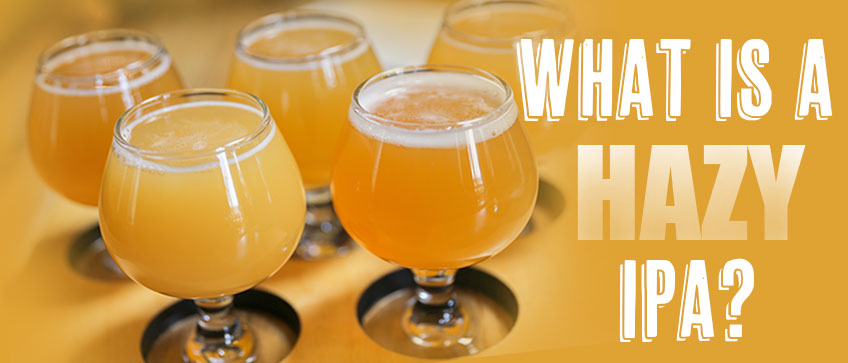
You've heard of it, you hear people talking about it, and you probably drink it but do you know what a Hazy IPA really is? The buzz term "Hazy" has become trendy and popularized in beer culture and it feels like every beer enthusiast is talking about this style of beer. However, many people don't actually know about what makes a Hazy, a Hazy. Luckily, we have some of the best brewers working for us and they're here to help explain what makes this style of beer so popular and so different from traditional IPAs.
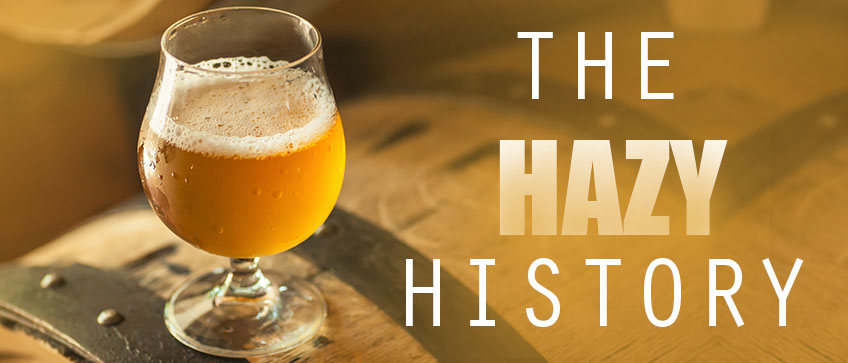
The Hazy History
Vermont, circa the mid-1990s, dial-up internet was the only means of accessing the internet and IPAs were still a clear beer. One day, The Alchemist's "Heady Topper" was born from the great brewmaster, John Kimmich.
The "Hazy" title didn't come about until its widespread popularity, so this beer is often also referred to as New England Style IPA or Vermont Style IPA. While it was created in the United States, this sub-style of IPA is actually considered a "Specialty IP" and not an "American IPA", like many would assume.
In the era where the most prized IPAs were exceptionally clear, like a high-quality diamond, this new style of IPA broke free from tradition and has now become one of the trendiest beers around. It's iconic juicy flavors and lusciously syrupy texture defied the traditional IPA style in taste, consistency, and appearance.
Its unique brewing process uses traditional brewing methods in a very different way, creating something that has a very different flavor profile from traditional IPAs. Hazy IPAs were a bit of black sheep in the beer community when it was first created, however, because of its unique flavor and texture, it was quickly replicated by other brewers and today is one of the most popular beer styles available.
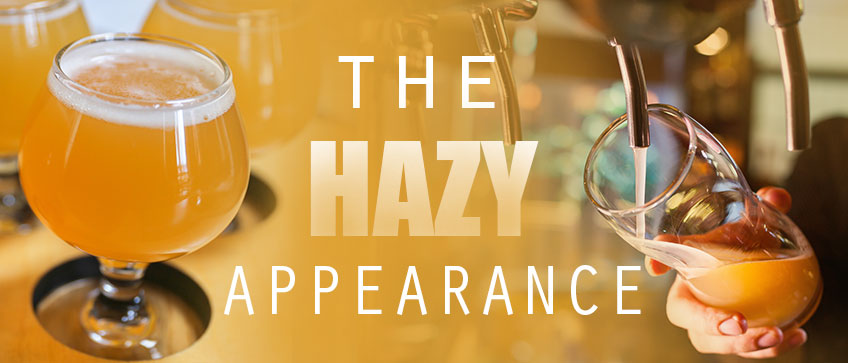
The Hazy Appearance
Ale yeast, used to brew all ales, is typically known as "top-fermenting" yeast. This means that during the fermentation process, the yeast will rise to the top and as the fermentation is ending, it will drop to the bottom of the brewing vessel. Then, the beer is often filtered to crisp and clear of any particulates.
Read our article on Ales Vs. Lagers to learn more about yeast types and ales.
A Hazy IPA is named after its very obviously hazy or murky appearance caused by low flocculating yeast strain used in this beer. Sorry for getting all technical and nerdy on you, you're probably wondering what flocculating means. We promise it's not as dirty as it sounds.
It simply means that instead of the yeast clumping together or flocking together in a large mass and sinking down to the bottom of the brewing vessel at the end of the fermentation process, it remains individual particles that suspend in the beer. These yeast particles are what cause the iconic hazy appearance to the beer.
The other culprit that adds to the hazy appearance of this beer is hops, specifically the dry-hopping process. An excessive amount of hops is added to hazy beers often while the wort is in the secondary fermenting vessel. These dry hops add a ton of particles that suspend in the beer adding to its thick and rich body and also, allowing the sweet and fruity aromas to come through, minimizing the hoppy bitterness of the beer.
The dry hops have a dusty consistency and easily break into particles and hop oil that suspends in the beer, enhancing that iconic hazy appearance. These fine suspended particles of hops, known as hop polyphenols, add the light bitterness and thick body to a Hazy IPA. There is a noticeable thickness and viscosity to a Hazy IPA that you can see but it is most noticeable when you're drinking it.
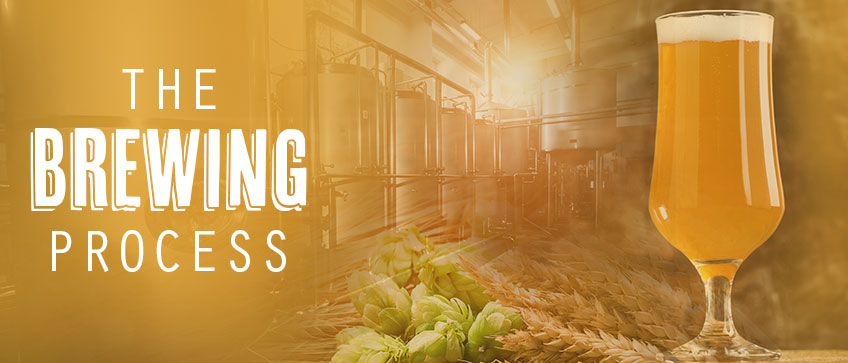
The Brewing Process
We have already discussed the unique nature of the yeast used in a Hazy IPA but it is the brewing method used that really sets the beer apart from other IPAs. Unlike the rest of the IPA family, Hazy IPAs are brewed by adding hops after the boiling process, while in the secondary fermenting vessel. This process is known as dry-hopping because dry hop pellets are poured into the liquid or wort after extracting it from the primary fermenting vessel.
In some cases, hops are added while in the secondary fermenting vessel and again after some time to add even more hop aroma to the beer. This double-dry-hopping gives the beer an even more intense hops flavor and aroma but lacks the bitterness of a hoppy IPA. Most importantly, unlike other beers, the hops are not filtered out but are a part of the character of the beer.
Dry-hopping is a process that occurs in other styles of beer but these styles don't have a hazy appearance because they don't use the outrageous volumes that are used in a Hazy IPA. The dry-hop pellets are added in such a massive quantity that it gives the beer its famous viscous and juicy mouthfeel because all the hop particles are suspended and floating around in the beer.
This hopping style also gives the beer its iconic floral and fruity aromas and flavors that make a Hazy beer so appealing. Unlike other IPA styles, Hazy IPAs have a very strong floral and fruity aroma that adds to the sensorial experience.
When hops are boiled, they add bitterness to the beer and the longer they are boiled the bitterness is further enhanced. Since the hops aren't often boiled when brewing a Hazy IPA, they don't release the same harsh bitterness and bite that you get from traditional IPAs. This is why you mostly get the fruity, floral, and bright hoppy flavor and minimal bitterness.
Finally, there is a special chemical reaction that occurs between the yeast and hops oils that create the unmistakable fruity and juicy aroma and taste.
Brew your own Hazy IPA with premium yeast options and premium hops available at the Beverage Factory.
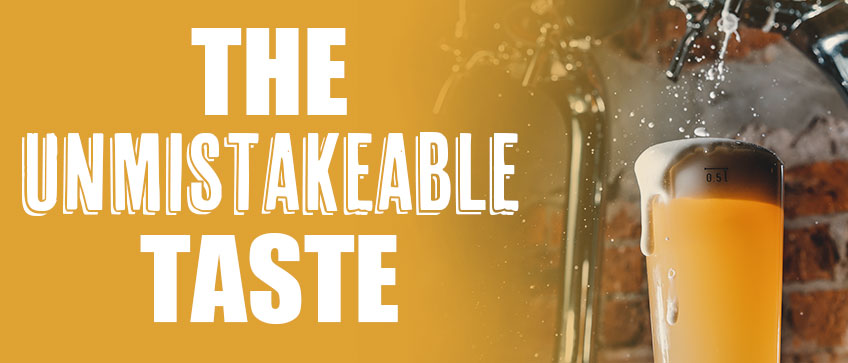
The Unmistakable Taste
A Hazy IPA has an unmistakable juicy IPA flavor and a rich, silky texture. Similar to the mouthfeel of juice, they tend to have a fruit-forward hop flavor and viscosity. Often brewed with citrus and fruit flavors, these notes are enhanced by the floral and bright hops. Frequently described as tropical in flavor, this style is kind of the black sheep of IPAs when it comes to flavors because its flavor profile is so different from traditional IPAs.
Due to its thick and syrupy texture, it is often confused with a milkshake IPA, however, the two are different styles of IPA. The viscous texture adds an enjoyable sensation and mouthfeel that almost offers the impression that you aren't drinking a beer. Many people liken it to the texture of orange juice and since it often has an orange hue, it is described as being a juicy beer.
Also, unlike a west coast IPA, a Hazy IPA doesn't have the strong hoppy bitterness often associated with IPAs. Again, this is due to the hopping process occurring after the boiling process. When hops are boiled they release a bitter flavor but when added in a cold fermentation stage, they mostly offer their aroma and a light hop flavor.
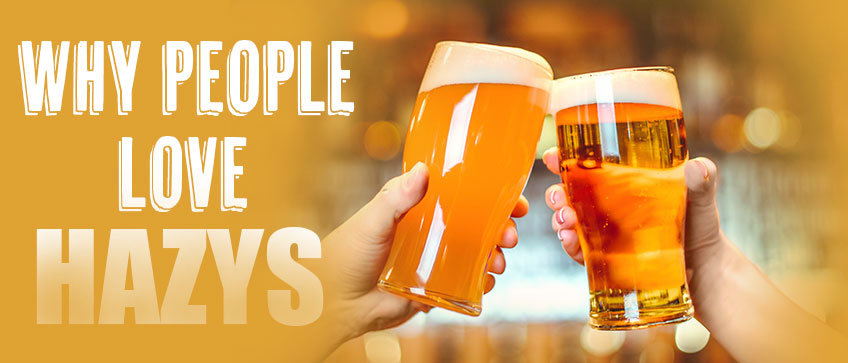
Why People Love It
This IPA has become so wildly popular because they have such a different flavor profile to traditional IPAs. They are so different that IPA purists and fans of the traditional IPA styles, wouldn't consider this beer to be in the same family. Like a distant cousin, the Hazy IPA has the same base and structure of an IPA. It is made with the same family of yeast, just a special strain.
People are loving this new variety of IPA because they are so easy to drink. With typically a light bitterness, those who are both IPA fans and those who aren't, love this beer. Since the strong hop notes in this beer come from mainly the aroma and the appealing fruity flavor, this beer is appealing to those who are not a fan of the traditional hoppiness of IPAs. Also, those new to beers or IPAs find the strong fruity flavors and the lack of bitterness extremely appealing.
The strong fruit and citrus flavors are often reminiscent of juice, making it very enjoyable. Additionally, the unique sensory experience of the silky, rich, and thick mouthfeel is something that you don't often get from a beer.
At one point, this texture and haziness were frowned upon but now brewers are finding new ways to brew this hazy variety of IPA. Some brewers go as far as dumping unspeakable amounts of hops into their brews during the dry-hopping process. These variations in the brewing process have led to wildly different and interesting Hazy beers.


 Single Faucet Kegerator Beer Dispensers
Single Faucet Kegerator Beer Dispensers Dual Faucet Two Tap Kegerators
Dual Faucet Two Tap Kegerators Triple Faucet Three Tap Kegerators
Triple Faucet Three Tap Kegerators Undercounter Built-In Kegerators
Undercounter Built-In Kegerators Outdoor Kegerator Beer Dispensers
Outdoor Kegerator Beer Dispensers Commercial Kegerators
Commercial Kegerators Mini Kegerators
Mini Kegerators Cold Brew & Nitro Coffee Dispenser Kegerators
Cold Brew & Nitro Coffee Dispenser Kegerators Carbonated Water Kegerators
Carbonated Water Kegerators Home Brew Kegerators
Home Brew Kegerators 15" Kegerators
15" Kegerators Kombucha Equipment
Kombucha Equipment Guinness® Dispensing Kegerators
Guinness® Dispensing Kegerators Vending Kegerators
Vending Kegerators Wine Kegerators
Wine Kegerators Kegerator Cabinets
Kegerator Cabinets Kegerator Covers and Accessories
Kegerator Covers and Accessories Kegerators
Kegerators Kegerator Conversion Kits
Kegerator Conversion Kits Kegs & Keg Accessories
Kegs & Keg Accessories Beer Faucets
Beer Faucets Beer Shanks
Beer Shanks Draft Beer Towers
Draft Beer Towers Keg Taps Couplers
Keg Taps Couplers Regulators & Gas Equipment
Regulators & Gas Equipment Beer & Gas Line Hose
Beer & Gas Line Hose Co2 and Nitrogen Air Tanks
Co2 and Nitrogen Air Tanks Beer Line Cleaning Equipment
Beer Line Cleaning Equipment Drip Trays
Drip Trays System Fittings
System Fittings Jockey Boxes
Jockey Boxes Keg Beer Party Pumps
Keg Beer Party Pumps Glassware & Accessories
Glassware & Accessories Guinness® Dispensing Equipment
Guinness® Dispensing Equipment Remote Glycol Systems
Remote Glycol Systems Wine Cooler Refrigerators
Wine Cooler Refrigerators Wine Cellar Cabinets
Wine Cellar Cabinets Wine Racks
Wine Racks Cooling Units
Cooling Units Wine Dispensing Systems
Wine Dispensing Systems Wine Glasses
Wine Glasses Wine Accessories
Wine Accessories Howard Miller Wine & Spirits Furniture
Howard Miller Wine & Spirits Furniture Wine Making
Wine Making Nitro Hot Draft System
Nitro Hot Draft System Ready to Drink Bag-in-a-Box Coffee Dispenser
Ready to Drink Bag-in-a-Box Coffee Dispenser Nitrogen Infusers
Nitrogen Infusers Nitrogen Beer Regulators
Nitrogen Beer Regulators Nitrogen Tanks & Generators
Nitrogen Tanks & Generators Nitro Cold Brew Coffee Kegs
Nitro Cold Brew Coffee Kegs Cold Brewed Coffee Tools
Cold Brewed Coffee Tools Espresso Machines
Espresso Machines Cleaning Equipment
Cleaning Equipment Outdoor Appliances
Outdoor Appliances ADA Appliances
ADA Appliances Panel Ready Appliances
Panel Ready Appliances Commercial Grade Appliances
Commercial Grade Appliances Beverage Centers
Beverage Centers Refrigerators
Refrigerators Ice Makers
Ice Makers Water Dispensers & Accessories
Water Dispensers & Accessories Freezers
Freezers Blenders & Juicers
Blenders & Juicers Home Brew Equipment Kits
Home Brew Equipment Kits Fermentation Equipment
Fermentation Equipment Boiling and Mashing Equipment
Boiling and Mashing Equipment Home Brew Beer Kegs
Home Brew Beer Kegs Home Brew Kegerator Conversion Kits
Home Brew Kegerator Conversion Kits Brewing Tools
Brewing Tools Home Brew Ingredients
Home Brew Ingredients Cleaning Chemicals
Cleaning Chemicals Test Equipment
Test Equipment Home Brew Beer Bottles and Bottling Equipment
Home Brew Beer Bottles and Bottling Equipment Brewery Fittings
Brewery Fittings Draft Beer Equipment
Draft Beer Equipment Homebrewing Equipment
Homebrewing Equipment Wine Equipment
Wine Equipment Luxury Appliances and Refrigeration
Luxury Appliances and Refrigeration Coffee Equipment
Coffee Equipment Home Bar & Barware
Home Bar & Barware Kombucha
Kombucha The Beverage Blog
The Beverage Blog Frequently Asked Beer Questions
Frequently Asked Beer Questions Shop by Brand
Shop by Brand Shop by Category
Shop by Category



